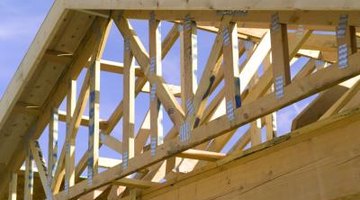What R-Value Should I Use for 2x10 Rafters on a Vaulted Ceiling?
Insulation is an important part of keeping your home running smoothly and efficiently. When placing insulation in your vaulted ceilings, it is beneficial to install insulation products that have the proper R-value into 2x10 framing. Both rigid foam insulation and blanket insulation fit into framing on vaulted ceilings.
R-Value

The effectiveness of insulation is measured by R-value, which indicates how well the insulation will resist heat transfer. Insulation with higher R-values are the most efficient and effective. Determining which R-value is right for your vaulted ceiling depends on the climate where you live, your lifestyle and the type of heating system you have in place.
Types
Rigid foam board insulation comes in panels that can be installed into 2x10 framing. These panels provide resistance to heat transfer through the wooden rafters of your ceiling. When installing rigid foam board insulation, the United States Department of Energy recommends choosing a product that has an R-value of 3.8 to 4.4 per inch of thickness. Blanket insulation comes in batts and rolls, which can be placed into 2x10 framing of your vaulted ceiling. High-density batts in R-30 or R-25 are recommended for vaulted ceilings.
Installation
Insulation must be installed into 2x10 framing in a manner that leaves room for proper ventilation. According to the United States Department of Energy, a vent baffle must be installed between the roof decking and the insulation. Failure to leave room for ventilation or failing to install the proper baffles will result in hot outdoor air coming in and out of your home, which increases energy usage. If the framing in your vaulted ceiling does not allow room for insulation and ventilation, attach strips to the rafters to hold insulation in place.
Considerations
If you install rigid foam board insulation, building codes require it to be covered with a fire-rated product or material. In most areas, drywall is sufficient for this purpose. Blanket insulation does not have to be covered. Once your insulation is placed in your vaulted ceiling, inspect your home for other areas where additional insulation could increase the energy efficiency of your home. Attics and basements are two areas that may benefit from installation of additional insulation.
Writer Bio
Tracy Hodge has been a professional writer since 2007. She currently writes content for various websites, specializing in health and fitness. Hodge also does ghostwriting projects for books, as well as poetry pieces. She has studied nutrition extensively, especially bodybuilding diets and nutritional supplements.
Photo Credits
- Brand X Pictures/Brand X Pictures/Getty Images
More Articles



